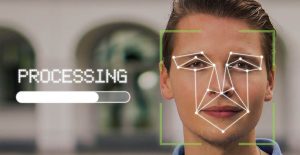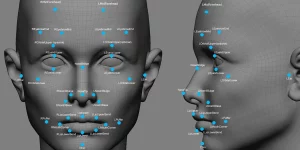Facial recognition technology is one of the products of Artificial Intelligence.
A facial recognition system is a technological piece that compares a human face in a digital photo or video frame to a database of faces.
It operates by recognizing and analyzing facial features in images. The concept of facial recognition may have once been something we only thought of in the context of science fiction films.
However, the technology is now used in public and private spaces.
How does facial recognition work?

The facial recognition system uses artificial intelligence technology to analyze an image to identify and measure the facial traits of a specific person.
It automates the analysis, extraction, and even understanding of information from an image utilizing a technique known as computer vision, where a computer or system can gather meaningful information from photos or videos and then execute an action using that data.
A facial recognition system can interpret someone’s face by examining their facial geometry and expressions.
It examines various information, such as the space between the eyes, the distance between the nose and mouth, the curve of the cheekbones, and the length of the face from forehead to chin.
This will then be converted into a faceprint, which will differ for each individual. Once completed, the facial recognition system can use this for several purposes.
What types of apps or software are used for facial recognition?
![]()
There are different types of facial recognition software accessible nowadays.
Below is a list of facials that are now on the market. Some also have free trial plans;
Microsoft’s Azure Face API
It has face detection technology and can recognize an individual by comparing their face to a private database or looking at their photo ID.
The good news is that using the API is all you need to accomplish facial recognition; You don’t need prior machine learning knowledge.
It offers two pricing plans: a free program with 30,000 free transactions each month or a standard tier with a starting price of £0.831 per 1,000 transactions and a monthly transaction limit of 1 million.
AMAZON RECOGNITION
Without spending time creating machine learning models, you can include Amazon Rekognition’s computer vision APIs in your apps.
It states that it can quickly analyze millions of photos or movies.
Face comparison and search, text detection, and video segment detection are a few of the features.
You can analyze 5,000 pictures per month and save 1,000 face metadata items in its free plan, which is good for 12 months.
Different price plans are available depending on how many photographs you intend to analyze each month. It has experienced tremendous growth and development over the recent years.
As this type of technology is implemented more widely globally, it is crucial to analyze some of its drawbacks in terms of performance.
As more businesses use this cutting-edge biometric technology, authentication will alter, becoming quicker, easier, and typically more accurate.
Read Also: Review of the best productivity apps for 2023
Drawbacks of Facial Recognition
An Imperfect System
The use of technology by law enforcement has come under scrutiny, particularly after police singled out demonstrators who opposed the shooting of George Floyd.
Due to this, businesses, including IBM, Amazon, and Microsoft, decided to stop selling and developing facial recognition technology.
The Court of Appeal in the UK determined that police use of the technology was illegal because it contravenes rules governing data protection, equality, and human rights.
This article from IT Pro explains the arguments for and against facial recognition, as the merits and cons of the technology are still up for debate.
This means the facial recognition system has some disadvantages, much like any other technology.
These include the potential for rights and liberties to be violated, the risk of data theft, and the danger of relying too heavily on unreliable technologies.
More drawbacks include;

Larger Risk To Personal And Social Privacy
One serious drawback of facial recognition technology is the potential threat to individual privacy.
Real-time face recognition surveillance by police enforcement is so fraught with privacy concerns that some localities, including Cambridge, Massachusetts, and San Francisco, California, have outlawed its usage.
Police can use recorded security camera footage but not real-time facial recognition software in these situations.
The previous information commissioner Elizabeth Denham called live facial recognition (LFR) cameras in public places “deeply concerning” last year.
Infringement of Personal Rights
Facial recognition data is regarded as a particular category of personal data under the GDPR as long as it is utilized for identification purposes in the UK.
A cross-party group of 67 MPs demanded in July 2022 that Hikvision and Dahua surveillance systems not be used in the UK due to ethical and security concerns.
These were based on information from reports like one from the LA Times that claimed Dahua created software that enabled its cameras to spot Uighur minorities and provide law enforcement users with a warning.
These were based on information from reports like the LA Times that claimed Dahua had created software enabling its cameras to recognize Uighur minorities and alert law enforcement users upon successful detection.
Creates data vulnerabilities
Facial recognition data storage is also a source of worry due to the vulnerability of these databases.
In the past, hackers accessed databases holding facial scans gathered and used by banks, police forces, and defense companies.
Threat actors might escalate the breach and gain access to even more sensitive data if they had facial data that was connected to a victim’s phone or that was connected to information about them in a banking database.
Enhances Fraud And Other Related Crimes
Lawbreakers can even commit crimes against innocent victims using facial recognition technologies.
To perpetrate identity fraud, they can gather people’s private information, including pictures and videos taken via facial scans and kept in databases.
With this knowledge, a criminal may open bank accounts, obtain other loans, and use credit cards in the victim’s name.
Threat actors might even put someone on a criminal record in light of using face recognition to add shoplifters to criminal databases, as described earlier.
Beyond fraud, criminals can use facial recognition technology to harass or pursue victims.
For instance, stalkers may use reverse image searches on photographs taken in public to learn more about their targets and intensify their harassment.
Rights organizations have called for stricter biometrics rules to cover technologies like live face recognition since facial recognition laws have fallen behind the technology’s potential application by criminals in recent years.
Also Read: The impact of mobile apps on the travel industry
Flawed Technology
The accuracy of facial recognition cannot be depended upon to replace human judgment because it is far from flawless.
The technology makes use of algorithms to match faces.
Due to the underrepresentation of people of color and women in the data set, some groups, like white men, benefit more from these algorithms than others, such as women and people of color.
Due to underrepresentation in the data set used to train the algorithm, some groups, such as white men, benefit more from these algorithms than others, such as women and different races.
This introduces accidental biases into the algorithms, which may result in biases in the technology’s decisions, such as making arrests.
Camera angles, lighting conditions, and image or video quality are among other elements that may also affect the technology’s capacity to recognize faces.
Slight adjustments to facial data, such as a fake mustache, can mislead less sophisticated facial recognition systems. In contrast, evil facial recognition technology can be fooled by a photo of a person it recognizes.
Erroneous Arrest Of Innocent People
In addition to the drawbacks of facial recognition, false positives have inherent risks. Such as erroneously classifying someone as a criminal, leading to false arrests.
A person’s reputation may suffer if they were included on a list of shoplifters, for example, or if facial recognition software incorrectly identified them as a criminal, leading to an arrest.
Big Brother Watch, a civil rights organization, revealed data in 2018 showing that the Metropolitan Police Service’s (MPS) use of face recognition technology frequently misidentified innocent people as criminals (98% of the time).
The drawbacks and risks of facial recognition technology may be lessened as it advances.
However, in the meantime, facial recognition technology is expected to be combined with other technologies to gain better results.
Gait recognition software will likely be employed with facial recognition technology to increase accuracy. Despite its many drawbacks, facial recognition technology does possess quite several advantages.
They include;
- Identifying perpetrators and finding missing people
- Protecting companies from theft
- Enhancing Banks and airport security measures
- It greatly decreases unnecessary human labor and interaction
- Better photo-organizing tools
But the question is, is it worth jeopardizing user privacy for efficiency and security?

